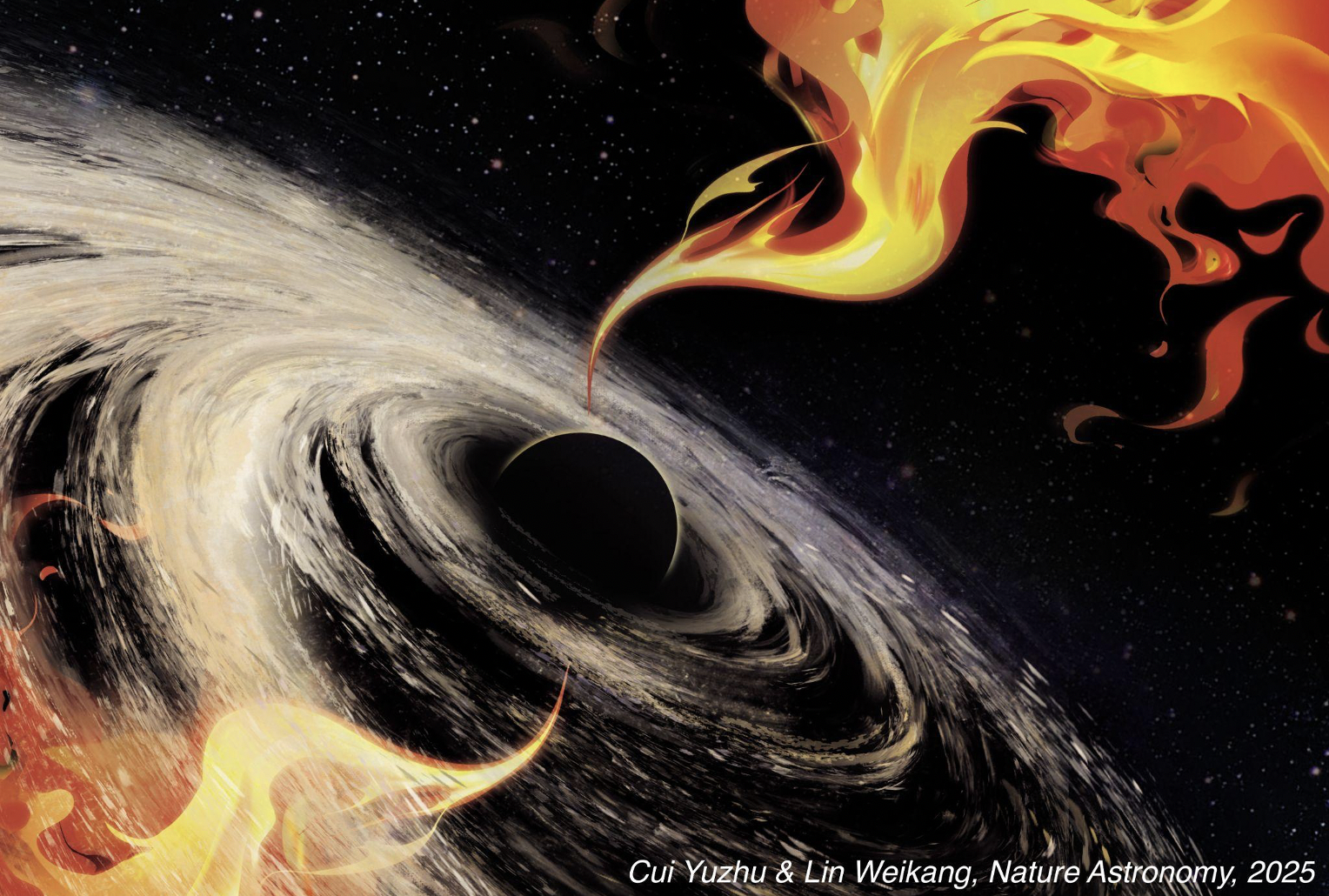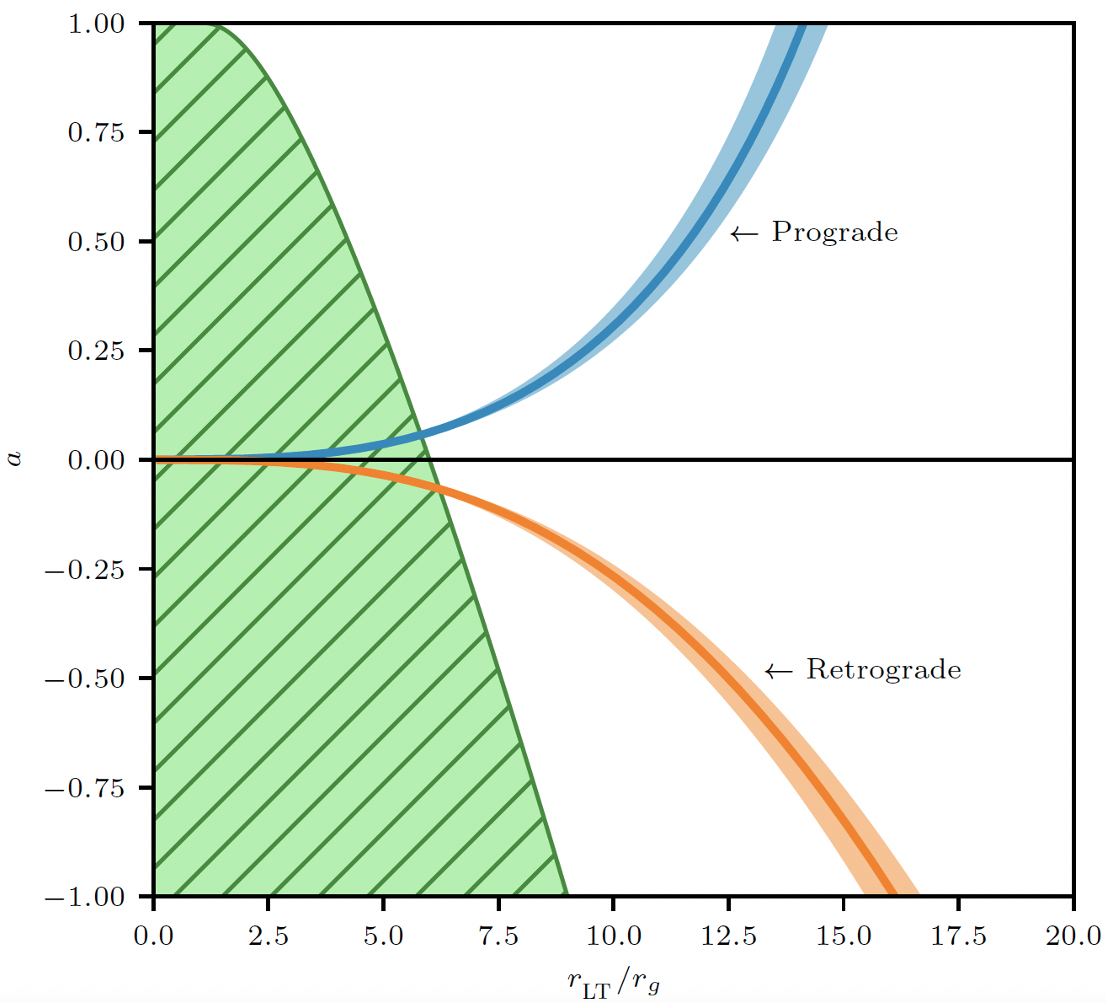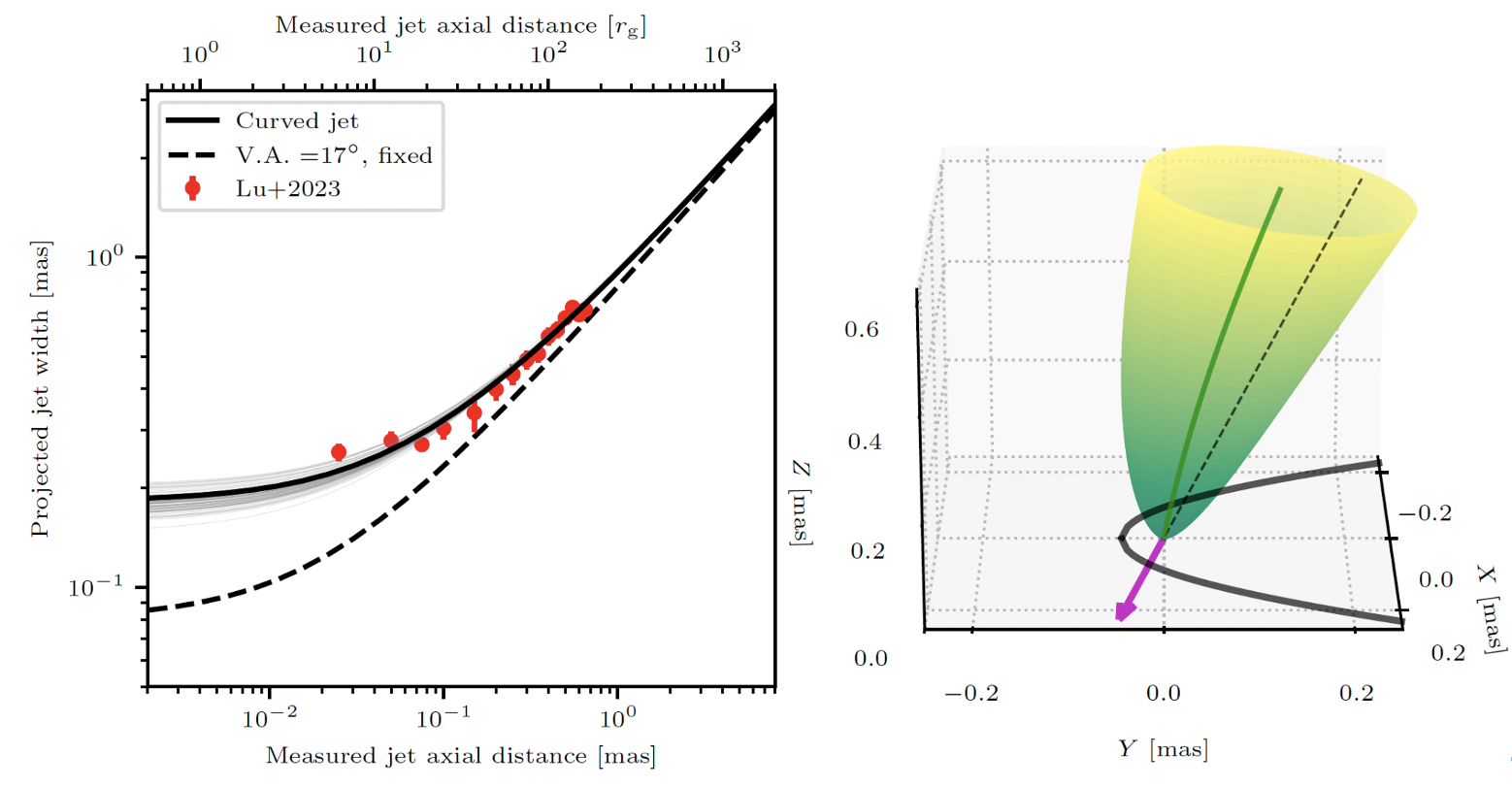新研究揭示了M87黑洞喷流与吸积盘“共舞”背后的物理结构
A New Perspective on the "Cosmic Waltz" Between M87's Black Hole Jet and Accretion Disk
继2023年首次发现M87星系中心黑洞喷流的周期性摆动后,云南大学西南天文研究所林伟康博士与华中师范大学天体物理研究所崔玉竹博士合作,在该星系黑洞-吸积盘-喷流进动系统的研究上再次取得一项突破性成果。基于对喷流根部的长期高精度观测,该项研究首次获得了M87吸积盘的致密结构,发现靠近黑洞部位的喷流存在与黑洞自旋动态关联的弯曲结构。该成果于2025年06月20日在《自然·天文学》(Nature Astronomy)杂志上发表,林伟康博士与崔玉竹博士为该论文的共同一作兼通讯作者,该项研究成果标志着对吸积盘与喷流进动的研究从“现象观测”迈入“系统结构剖析”的新阶段。
由“共舞”了解黑洞-吸积盘-喷流系统
M87距地球仅5500万光年,是离地球最近的活跃星系核(AGN)之一,其中心黑洞质量高达65亿倍太阳质量,引力效应显著,是研究强引力场、极端时空扭曲和黑洞性质的最理想实验室。2023年的研究工作(Cui et al. 2023, Nature)通过分析跨越23年的22GHz和43GHz观测数据,发现M87喷流以11年为周期摆动,这种摆动与爱因斯坦广义相对论预言的Lense-Thirring(LT)效应高度契合——当黑洞自旋时,其周围时空被拖曳,导致倾斜的吸积盘像陀螺般进动,进而带动喷流同步偏转,为黑洞存在自旋提供了最直接的观测证据。然而,喷流如何与吸积盘动态耦合、吸积盘的尺度有多大以及靠近黑洞的喷流有什么样的结构等核心问题仍悬而未决。
解码进动的吸积盘:一个紧凑的结构
吸积盘的大小与黑洞喷流的形成机制有着密切的联系,该项研究通过LT进动周期与吸积盘结构的联合推演,从观测数据中解码出M87中心吸积盘的小尺度特征,结果表明进动吸积盘必须十分紧凑,比文献中数值模拟假设的尺度还要小很多。此前有关吸积盘的研究,在观测上对小尺度结构的约束存在空白,这一新进展对从理论及数值模拟上理解吸积盘的物理性质有重要意义,为黑洞系统研究树立了跨尺度关联的范例。
弯曲的喷流:打破准直喷流的传统观念
此外,受喷流进动现象的启发,该研究推断喷流的结构可能存在弯曲。结合此前更高角分辨率的86GHz观测数据,该研究发现喷流根部的确存在弯曲结构,并且解释了喷流在靠近黑洞区域时异常大的宽度,表明在黑洞附近区域的喷流呈现出与吸积盘同步进动的动态弯曲结构。喷流根部弯曲结构的发现,进一步加深了对于相对论喷流形成机制的认识——喷流不仅是黑洞自旋能量释放的通道,还会受吸积盘及周围环境的作用下逐渐发生弯曲,越靠近黑洞弯曲程度也越显著。
未来展望
此项工作揭示了一条可能隐藏的宇宙规律——从M87中观测到的喷流-吸积盘协同进动机制或普遍存在于其他活动星系核中。该项研究为构建黑洞-吸积盘-喷流动态关联的理论奠定了基础,未来更高精度的观测将进一步研究吸积盘与喷流的相互作用,后续的研究有望在更精细的尺度上揭开极端引力环境下物质与能量形态的终极奥秘。
论文信息:
标题:Co-precession of a curved jet and compact accretion disk in M87
作者:崔玉竹(华中师范大学天体物理研究所,yuzhu.cui@ccnu.edu.cn)、林伟康(云南大学西南天文研究所,weikanglin@ynu.edu.cn)
期刊:《Nature Astronomy》
接收日期:2025年5月12日
DOI: https://www.nature.com/articles/s41550-025-02580-0
关联信息:
【1】Cui et al., Nature 621, 711–715 (2023), "Precessing jet nozzle connecting to a spinning black hole in M87" [DOI: 10.1038/s41586-023-06479-6]
【2】Lu et al., Nature 616, 686–690 (2023), "A ring-like accretion structure in M87 connecting its black hole and jet" [DOI: 10.1038/s41586-023-05843-w]
【3】EAVN主页:https://radio.kasi.re.kr/eavn/main.php
【4】EHT主页:https://eventhorizontelescope.org/
【5】ngEHT主页:https://www.ngeht.org/


图1. M87黑洞自旋参数(a)与有效的进动吸积盘半径(rLT)的约束关系,蓝/橙线分别代表吸积盘角动量相对于黑洞自旋为顺向/逆向。
Figure 1. Constraints on the M87 black hole spin parameter and the effective precession disk radius. The blue and orange curves denote prograde and retrograde disk angular momentum relative to the black hole spin, respectively.

图2. 黑洞喷流的弯曲结构。左图实线显示弯曲的喷流所推算出的其在临近黑洞区域的宽度(红线为观测数据[2]),右图为弯曲的喷流(绿色锥体)的三维模型,喷流绕着黑洞的自旋轴(洋红色)作“陀螺”般的运动。
Figure 2: Curved jet structure of the black hole. Left: The solid curve shows the inferred jet width profile near the black hole based on the curved jet model (red points: observational data[2]). Right: 3D model of the curved jet (green cone) precessing around the black hole's spin axis (magenta).

Following the first discovery of the periodic wobbling of the jet from the central black hole in the M87 galaxy in 2023, Dr. Weikang Lin from the Southwest Institute of Astronomy at Yunnan University and Dr. Yuzhu Cui from the Institute of Astrophysics at Central China Normal University have made another groundbreaking advancement in the study of the black hole–accretion disk–jet precession system. Based on observations of the jet base in M87, they inferred the presence of a compact accretion disk structure and identified a curved jet feature near the black hole that is dynamically linked to the black hole’s spin. This work was published in Nature Astronomy on June 20, 2025. Both Dr. Lin and Dr. Cui are co-first and co-corresponding authors of this work. The results mark a transition in the study of accretion disk and jet precession from observational phenomena to a structural understanding of the black hole system.
Unveiling the Black Hole-Accretion Disk-Jet from the "Cosmic Waltz"
Located 55 million light-years from Earth, M87 hosts one of the closest active galactic nuclei (AGN) to our galaxy. Its supermassive black hole, weighing 6.5 billion solar masses, serves as an ideal laboratory for studying extreme spacetime curvature. The 2023 study (Cui et al., Nature, 2023) analyzed 23 years of 22 GHz and 43 GHz observational data, revealing an 11-year precession cycle in the jet’s position angle. This motion aligns with the Lense-Thirring (LT) effect predicted by Einstein’s general relativity: the spinning black hole drags spacetime, inducing precession in a tilted accretion disk, which in turn drives synchronized jet deflection. While this provided direct evidence for black hole spin, critical questions remained—How do the jet and disk dynamically couple? What is the size of the disk? What jet structures form near the black hole?
Decoding the Precessing Disk: A Compact structure
The authors combine Lense–Thirring precession theory with the accretion disk’s mass distribution to decode the small-scale structure of M87’s disk. Their analysis reveals that the precessing disk must be highly compact, with an effective radius smaller than previously assumed in numerical simulations. Earlier studies lacked observational means to probe the disk’s microstructure. By analyzing milliarcsecond-scale jet kinematics over several decades, this breakthrough bridges a critical gap between theory and observation, setting a new benchmark for cross-scale research on black hole systems.
Curved Jets: Shattering the Myth of Perfect Collimation
Inspired by the jet precession model, the authors proposed that the jet structure may be intrinsically curved. By incorporating previously reported higher angular resolution observations at 86 GHz, the authors show that the jet indeed exhibits a bent structure, which reasonably explains the previously reported unexpectedly large jet width near the black hole. This indicates that the jet in the vicinity of the black hole is not strictly collimated but exhibits dynamic bending synchronized with the precession of the accretion disk. This finding advances our understanding of relativistic jet formation -- it suggests the jet is not only a channel for the release of black hole spin energy but may also be gradually shaped by interactions with its surrounding environment. The closer it is to the black hole, the stronger the influence, and the more pronounced the curvature.
Future Horizons
This work hints at a hidden cosmic rule: the coupled jet-disk precession mechanism observed in M87 may govern other AGN. Future high-precision, long-term observations using facilities such as the East Asian Very Long Baseline Interferometry Network (EAVN) , the Event Horizon Telescope (EHT), and the next-generation EHT (ngEHT) will enable further investigation into disk-jet interactions.
Paper Information:
Title: Co-precession of a Curved Jet and Compact Accretion Disk in M87
Authors:
Yuzhu Cui (Institute of Astrophysics, Central China Normal University, yuzhu.cui@ccnu.edu.cn)
Weikang Lin (South-Western Institute for Astronomy Research, Yunnan University, weikanglin@ynu.edu.cn)
Journal: Nature Astronomy
Accepted: 12 May 2025
DOI: https://www.nature.com/articles/s41550-025-02580-0
References:
[1] Cui et al., Nature 621, 711–715 (2023), "Precessing jet nozzle connecting to a spinning black hole in M87" [DOI: 10.1038/s41586-023-06479-6]
[2] Lu et al., Nature 616, 686–690 (2023), "A ring-like accretion structure in M87 connecting its black hole and jet" [DOI: 10.1038/s41586-023-05843-w]
[3] EAVN official website: https://radio.kasi.re.kr/eavn/main.php
[4] EHT official website: https://eventhorizontelescope.org/
[5] ngEHT official website: https://www.ngeht.org/
